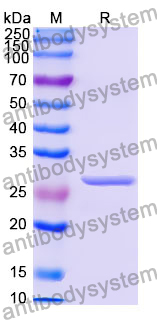Catalog No.
YHH28501
Expression system
E. coli
Species
Homo sapiens (Human)
Protein length
Ser140-Gly340
Predicted molecular weight
26.18 kDa
Nature
Recombinant
Endotoxin level
Please contact with the lab for this information.
Purity
>90% as determined by SDS-PAGE.
Accession
Q16543
Applications
ELISA, Immunogen, SDS-PAGE, WB, Bioactivity testing in progress
Form
Lyophilized
Storage buffer
Lyophilized from a solution in PBS pH 7.4, 0.02% NLS, 1mM EDTA, 4% Trehalose, 1% Mannitol.
Reconstitution
Reconstitute in sterile water for a stock solution. A copy of datasheet will be provided with the products, please refer to it for details.
Shipping
In general, proteins are provided as lyophilized powder/frozen liquid. They are shipped out with dry ice/blue ice unless customers require otherwise.
Stability and Storage
Use a manual defrost freezer and avoid repeated freeze thaw cycles. Store at 2 to 8°C for frequent use. Store at -20 to -80°C for twelve months from the date of receipt.
Alternative Names
CDC37, Hsp90 co-chaperone Cdc37, Hsp90 chaperone protein kinase-targeting subunit, p50Cdc37, CDC37A
Disrupting the Hsp90-Cdc37 axis: a selective strategy for targeting oncogenic kinases in cancer., PMID:40491798
Utilizing Multi-omics analysis to elucidate the role of mitochondrial gene defects in Gastric cancer progression., PMID:40489463
Discovery of new celastrol derivatives with antitumor activity in vitro and invivo by blocking Hsp90-Cdc37-kinase cycle., PMID:40472487
Dual-Site Targeting by Peptide Inhibitors of the N-Terminal Domain of Hsp90: Mechanism and Design., PMID:40310892
Structural Optimization of Pyrazole Compounds as Hsp90 Regulators with Enhanced Antitumor Activity., PMID:40310691
Effect of the CSFV NS5A protein on key proteins in the MAPK and PI3K-mTOR signaling pathways in porcine macrophages., PMID:40078537
Targeting the Protein-Protein Interaction Between the CDC37 Co-Chaperone and Client Kinases by an Allosteric RAF Dimer Breaker., PMID:40027753
Oncogenic non-V600 mutations evade the regulatory machinery of RAF including the Cdc37/Hsp90 chaperone and the 14-3-3 scaffold., PMID:39897565
Purification and characterization of full-length monomeric TEC family kinase, ITK., PMID:39894064
Mechanism of chaperone recruitment and retention on mitochondrial precursors., PMID:39878680
Targeting protein-protein interactions in drug discovery: Modulators approved or in clinical trials for cancer treatment., PMID:39667542
Allosteric CDC37 Inhibitor Disrupts Chaperone Complex to Block CDK4/6 Maturation., PMID:39582167
Cepharanthine inhibits African swine fever virus replication by suppressing AKT-associated pathways through disrupting Hsp90-Cdc37 complex., PMID:39486740
Exploring the anti-NSCLC mechanism of phillyrin targeting inhibition of the HSP90-AKT pathway., PMID:39356318
ITRAQ Based Proteomics Reveals the Potential Mechanism of Placental Injury Induced by Prenatal Stress., PMID:39337469
A comprehensive review on the dynamics of protein kinase CK2 in cancer development and optimizing therapeutic strategies., PMID:39306165
Identification of SYNJ1 in a Complex Case of Juvenile Parkinsonism Using a Multiomics Approach., PMID:39273702
Discovery of new Hsp90-Cdc37 protein-protein interaction inhibitors: in silico screening and optimization of anticancer activity., PMID:39239280
Modification of Regulatory Tyrosine Residues Biases Human Hsp90α in its Interactions with Cochaperones and Clients., PMID:39222679
Cancer-specific alterations in nuclear matrix proteins determined by multi-omics analyses of ductal carcinoma in situ., PMID:39165691
Correction for Huang et al., "p17-Modulated Hsp90/Cdc37 Complex Governs Oncolytic Avian Reovirus Replication by Chaperoning p17, Which Promotes Viral Protein Synthesis and Accumulation of Viral Proteins σC and σA in Viral Factories"., PMID:38953642
AURKB/CDC37 complex promotes clear cell renal cell carcinoma progression via phosphorylating MYC and constituting an AURKB/E2F1-positive feedforward loop., PMID:38890303
Regulation of RAF family kinases: new insights from recent structural and biochemical studies., PMID:38695730
Chaperones-A New Class of Potential Therapeutic Targets in Alzheimer's Disease., PMID:38542375
Regulation of cancer progression by CK2: an emerging therapeutic target., PMID:38526625
PARP1 Promotes Heart Regeneration and Cardiomyocyte Proliferation., PMID:38481797
Structural dynamics of RAF1-HSP90-CDC37 and HSP90 complexes reveal asymmetric client interactions and key structural elements., PMID:38431713
Cancer-Specific Alterations in Nuclear Matrix Proteins Determined by Multi-omics Analyses of Ductal Carcinoma in Situ., PMID:38405693
Predictive value of CDC37 gene expression for targeted therapy in metastatic colorectal cancer., PMID:38359495
Signaling from RAS to RAF: The Molecules and Their Mechanisms., PMID:38316136
Rational design of peptide inhibitors targeting HSP90-CDC37 protein-protein interaction., PMID:38189168
Ginsenoside Rg5 enhances the radiosensitivity of lung adenocarcinoma via reducing HSP90-CDC37 interaction and promoting client protein degradation., PMID:38174116
TMT-based proteomics analysis of sea urchin (Strongylocentrotus intermedius) under high temperature stress., PMID:38159402
Comparative Transcriptomic Analyses Propose the Molecular Regulatory Mechanisms Underlying 1,8-Cineole from Cinnamomum kanehirae Hay and Promote the Asexual Sporulation of Antrodia cinnamomea in Submerged Fermentation., PMID:38005233
Pazopanib ameliorates rotenone-induced Parkinsonism in rats by suppressing multiple regulated cell death mechanisms., PMID:37820786
[Risk modeling based on HER-2 related genes for bladder cancer survival prognosis assessment]., PMID:37807731
Identification of FAM53C as a cytosolic-anchoring inhibitory binding protein of the kinase DYRK1A., PMID:37802655
BRAFΔβ3-αC in-frame deletion mutants differ in their dimerization propensity, HSP90 dependence, and druggability., PMID:37656784
Characterization and expression of heat shock and immune genes in natural populations of Prodiamesa olivacea (Diptera) exposed to thermal stress., PMID:37595349
Multiple Targeting of HSP Isoforms to Challenge Isoform Specificity and Compensatory Expression., PMID:37540433
Quantitative Proteomics of the CDK9 Interactome Reveals a Function of the HSP90-CDC37-P-TEFb Complex for BETi-Induced HIV-1 Latency Reactivation., PMID:37540094
Structural insight into guanylyl cyclase receptor hijacking of the kinase-Hsp90 regulatory mechanism., PMID:37535399
HSP90/CDC37 inactivation promotes degradation of LKB1 protein to suppress AMPK signaling in bronchial epithelial cells exposed to sulfur mustard analog, 2-chloroethyl ethyl sulfide., PMID:37481222
Thioredoxin-1 inhibits the activation of IRE1 by targeting Hsp90/p-Cdc37 chaperone complex in Parkinson disease., PMID:37437766
Cell division cycle 37 change after bortezomib-based induction therapy helps to predict clinical response and prognosis in multiple myeloma patients., PMID:37409850
Lapatinib ditosylate rescues motor deficits in rotenone-intoxicated rats: Potential repurposing of anti-cancer drug as a disease-modifying agent in Parkinson's disease., PMID:37385578
Phosphatases maintain low catalytic activity of SGK1: DNA damage resets the balance in favor of phosphorylation., PMID:37343701
Rational design, synthesis and structural characterization of peptides and peptidomimetics to target Hsp90/Cdc37 interaction for treating hepatocellular carcinoma., PMID:37304004
Mincle-GSDMD-mediated release of IL-1β small extracellular vesicles from hepatic macrophages in ethanol-induced liver injury., PMID:37185170
TTT (Tel2-Tti1-Tti2) Complex, the Co-Chaperone of PIKKs and a Potential Target for Cancer Chemotherapy., PMID:37175973

